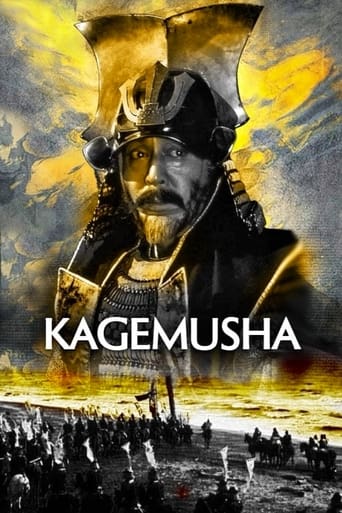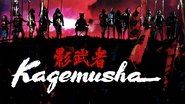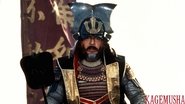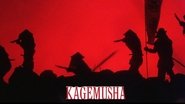cinemajesty
Film Review: "Kagemusha" (1980)Winning the "Palme d'Or" shared with Bob Fosse's "All That Jazz" (1979) on May 23rd 1980 at Cannes Film Festival in its 33rd edition, director Akira Kurosawa (1910-1998) accumulates all his directorial signatures since "Rashomon" (1950) to adapt an originally screen-written masterpiece on thief impersonating a dying king-like figure alongside Japanese moviestars Tsutomu Yamazaki and Tatsuya Nakadai in a legendary double role as medieval warlord Shingen Takeda as the title-given imposter to take his place in a troublesome kingdom to tragic as high-suspense drama indulging ends, when well-researched art directions by ingenious Kurosawa-collaborator production designer Yoshiro Muraki (1924-2009) delivers with visual splendors to be hypnotized from that even international distribution-securing producers George Lucas and Francis Ford Coppola must have admit that "Kagemusha" remains world cinema at its best to be discovered again in an all-too-fast moving environment of speeding visuals from any digital device coming our way these days.Copyright 2018 Cinemajesty Entertainments LLC
gavin6942
A petty thief with an utter resemblance to a samurai warlord is hired as the lord's double. When the warlord later dies the thief is forced to take up arms in his place.George Lucas and Francis Ford Coppola are credited at the end of the film as executive producers in the international version. This is because they convinced 20th Century Fox to make up a shortfall in the film's budget when the original producers, Toho Studios, could not afford to complete the film. In return, 20th Century Fox received the international distribution rights to the film.According to Lucas, Kurosawa used 5000 extras for the final battle sequence, filming for a whole day, then he cut it down to 90 seconds in the final release. Many beautiful special effects, and a number of scenes that filled holes in the story, landed on the "cutting-room floor." The version I watched was edited for international distribution. Now, if there is an even longer version than the Japanese version, this is one heck of a samurai epic. That would be what, four hours? And definitely among the best -- if not the very best -- of Kurosawa's later work. Holy moley, those colors! Again, the version I saw seemed to be in standard definition. If Criterion released this in 4K, it would blow minds. (Maybe they have, I don't know.) An absolute must-see for Kurosawa fans or fans of the samurai film (two groups that I presume have plenty of overlap).
nightwolf517
I thought that it was very interesting to find out that this movie actually had problems getting the funds necessary to finish the film. George Lucas and Francis Ford Coppola helped convince 20th Century-Fox to fund the remaining portion of the budget in exchange for international distribution rights for Kagemusha. I thought it was neat how Kurosawa create huge battle scenes with little funding. He created the 'illusion' of a huge battle by showing scenes of marching soldiers, small clips of battle scenes, and sound effects. It is unbelievable that this film was so close to not getting produced because of the funding difficulties. I am very happy that this film got the funding it needed.
sboom2009
Another samurai epic by the master of the genre Akira Kurosawa; which, I find to be a mostly fulfilling attempt.The film follows the life of a peasant thief named Kagemusha who happens to look like the warlord of the Takeda clan Shingen. He is found by Shingen's brother Nobukado where he is trained to be Shingen's third body double in case of emergency. Of course this fate is realized when a assassin's sniper rifle finds Lord Shingen during a battle. Shengin remains alive for a while to let his men know that he wanted to be alive three more years for it was his goal to capture Kyoto and if he should die he would want it kept a secret so his clan would not go into disarray. Unfortunately Shingen passes from his wound and it is decided by the his cabinet that Kagemusha must pretend to be Shingen for three years (this secret is even kept from Shingen's family).It is important for his double to keep his persona for if his enemies were to suspect lord Shigen dead then they wouldn't have fear of attacking, but knowing that he may still be living made them second guess their attacks and kept the clan safe. It also helped to protect the clan from itself for the warlords replacement was a mere boy and a son who is blanketed by his father's shadow who is trying desperately to find himself(which is a major theme of the film).Their are many themes in this film of which to talk about but the most important one is finding ones self. Shingen's son Katsuyori is very lost even before his father's death. His son is the next in line to become leader of the clan ,which; brings him much embarrassment for he has felt his father was not fairing of him making him want to distance himself from Shingen's lore. These feelings later in the film become cataclysmic as certain discoveries are made. Kagemusha himself is lost between loyalty to his master and still knowing himself ,which; he is not able to be under the circumstances. There is a point in the film when he takes the persona too far it has dire consequences, but it puts things back in perspective for him where he finds what he truly loves.The first two hours of the film are phenomenal, but the battle sequences once began got a little confusing at times especially a scene at night where you're not sure who the friends or enemies are. I didn't fully understand the sequence until it had ended and I felt it was the weakest part of the film lasting I believe between 15-20 minutes. I wasn't a big fan of the ending also it felt a little rushed to me for Kurosawa ,which; I find to be out of character for him, but I will say the films final shot was magnificent.To Conclude I would say that despite the weak final act the rest of the film was very entertaining with an interesting premise and strong characters. If you are a Kurosawa fan you will love it as I did, however; it is definitely not in the category of Seven Samurai, or Roshomon. Visually astounding(the nightmare sequence was my favorite) at times and maybe a little confusing at others in the end it is to good of a film to pass up on even if it has its flaws.










